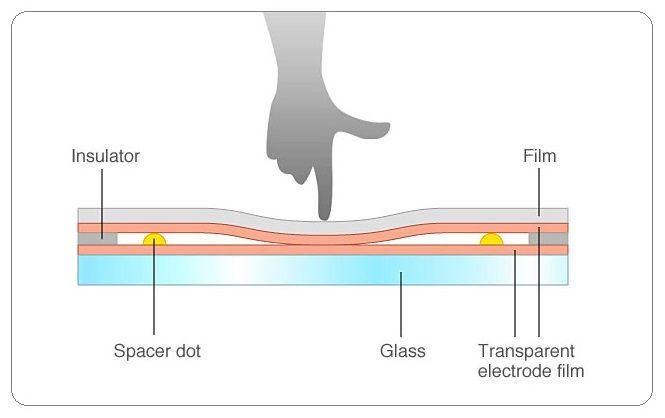Touch Screen History
The first touch screen idea was explained and published in the year 1965 by E.A. Johnson. After that, in the year 1970, the first touch screen was developed by CERN engineers namely Bent Stumpe & Frank Beck. The first touchscreen-based device was designed as well as used in the year 1973. By George Samuel Hurst, the first resistive touch screen was developed in the year 1975 but wasn’t released and used till the year 1982.

Introduction
At present, touch screen technology has become well-known to many of us. Because electronic manufacturers use this technology in the display screens of various electronic devices like smartphones, tabs, computers, ATM displays, navigation systems in cars, etc. Nowadays, touch screen technology is used in some PCs which run through Microsoft Windows 10. The computer makers with products that include touch screen technology mainly include Dell, Acer, Microsoft, Lenovo, HP & other personal computer makers.
What is a Touch Screen?
A display technology like touch screen allows the user to operate with the help of a finger otherwise stylus pen. This is an alternative to a keyboard or a mouse to navigate a graphical user interface (GUI).



This technology is applicable in the display of different electronic devices like mobiles, computers, tablets, etc. Some touchscreen-based devices use a network of IR beams so that a finger presence can be sensed in place of using touch-sensitive input.
For instance, a touchscreen-based computer device that gets the input from the user who is operating the device. Here the device is considered an input device. The way we utilize the mouse of a computer is extremely related to how you use your finger over a touch screen.
How Touch Screen Works?
There are different types of touch screens available in the market, based on the type the working will change in different ways. Because, some touch screens detect only one finger at a time whereas in other types of touch screens, one can simply sense & differentiate above one key push at once.



The different types of touch screens are discussed below where each type will assist you to choose which type of touch screen is most suitable for your requirements:
Different Types of Touch Screen Technology
The types of touch screens are resistive type, surface capacitive, projected capacitive saw touch and infrared touch.



Resistive Touch
At present, the most widely used touch screen is resistive touch because the monitor of this touch screen is designed with a film screen or a glass panel. This is enclosed with a slight metallic layer and divided through a slight gap. Once an operator fingers the monitor, then two metallic layers build contact. The contact point can be noticed through the change within voltage.
The advantages of this touch screen include; it activates with any object like a finger, pen, stylus, uses less power, and less cost. The disadvantages are; image clarity is less as compared with other technologies and external film can be damaged once it scratched or poked.
Surface Capacitive
In this type of touch screen, a crystal clear electrode coating can be located over a glass panel & enclosed with a defensive cover. Once a finger contacts the screen of the monitor, then it responds to the motionless electrical capability of the human body. Some electrical charge can be transferred from the monitor to the operator. This kind of touch screen activates through the touch of human skin otherwise a stylus pen clutching an electrical charge.
The advantages of this kind of touch screen include; strong screen, scratch resistance is high and image clarity is better. The disadvantages are; it uses user finer or stylus for its operation.
Projected Capacitive
This type of touch is composed of a glass sheet including an IC and an embedded crystal clear electrode to create a 3-dimensional field of electrostatic. Once the user’s finger touches the computer the screen, then the electrical current ratios will vary & the PC is capable to notice the touch ends.
The advantages of this touch screen include; image clarity is good, supports multi-touch, and more resistant. The disadvantages are; this type of screen is sensitive to RFI/EMI
SAW Touch
This type of screens uses a set of piezoelectric transducers &receivers to make an unseen network of ultrasonic waves over the screen. Once the screen is tapped, a part of the wave can be attracted. So this lets the receiving transducer to situate the touch end & transmits the data to the PC. These monitors can be turned on through a finger, soft-tip stylus or gloved hand.
The advantages of this touch screen include; image clarity is good, touch life is high, scratch resistance is good. The disadvantages are; it doesn’t activate with pen or nail and water drops on the screen may cause damage.
Infrared Touch Screen
In this touch screen, IR monitors utilize infrared emitters & receivers to make an unseen network of light beams around the screen. Once an object disrupts the unseen IR light beam, then the sensors are capable to place the touch end.
The advantages of this kind of touch screen include; touch life is limitless, image clarity is high. The disadvantages are; oil, dust on-screen could obstruct light beam causing a breakdown, high cost, etc.
Thus, having a touch screen as an alternative of numerous buttons can make an electronic device lesser. Designing cost is cheap due to a device including one screen instead of a number of buttons. The applications of touch screen mainly include PCs, ATMs, GPS based Cars, Cameras, Mobiles, Tabs, Monitors, gas stations, and many more.
Leave a Reply